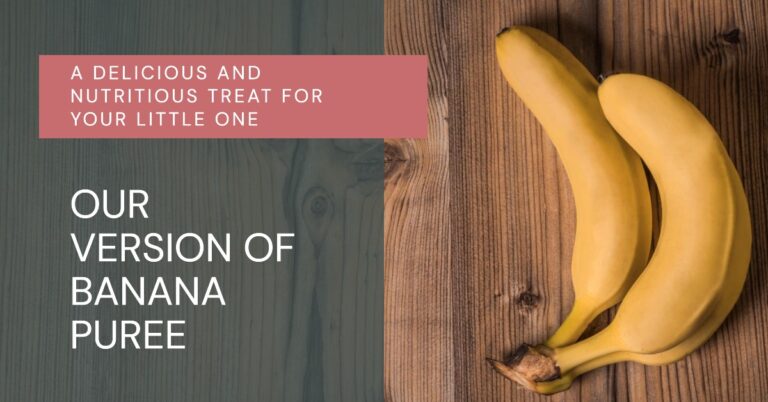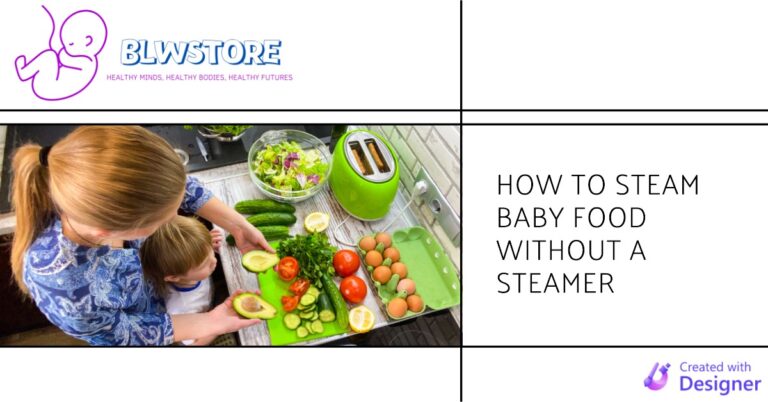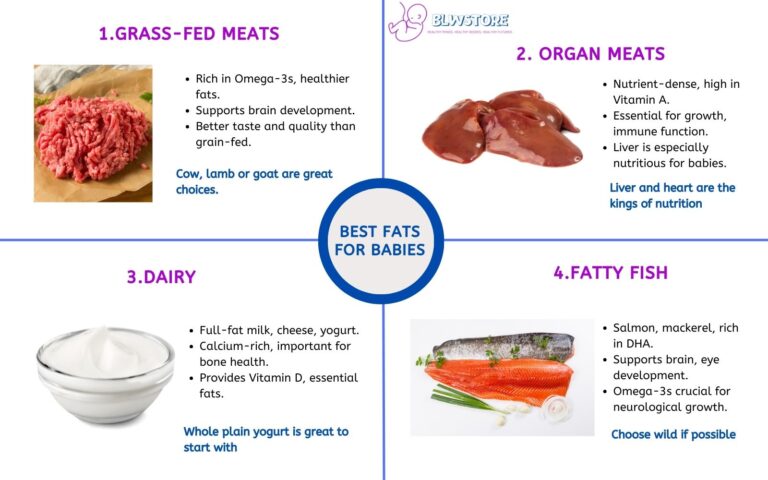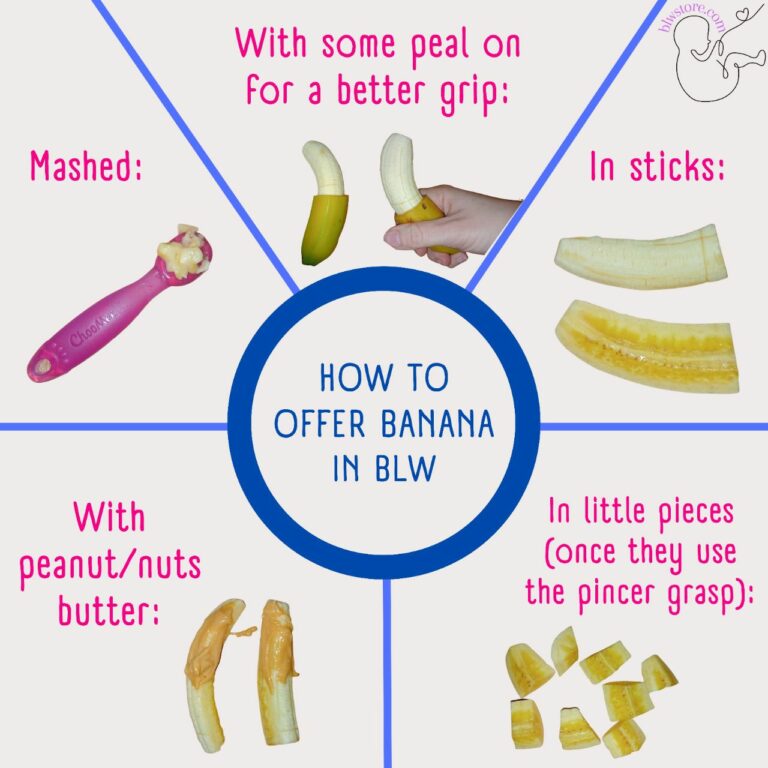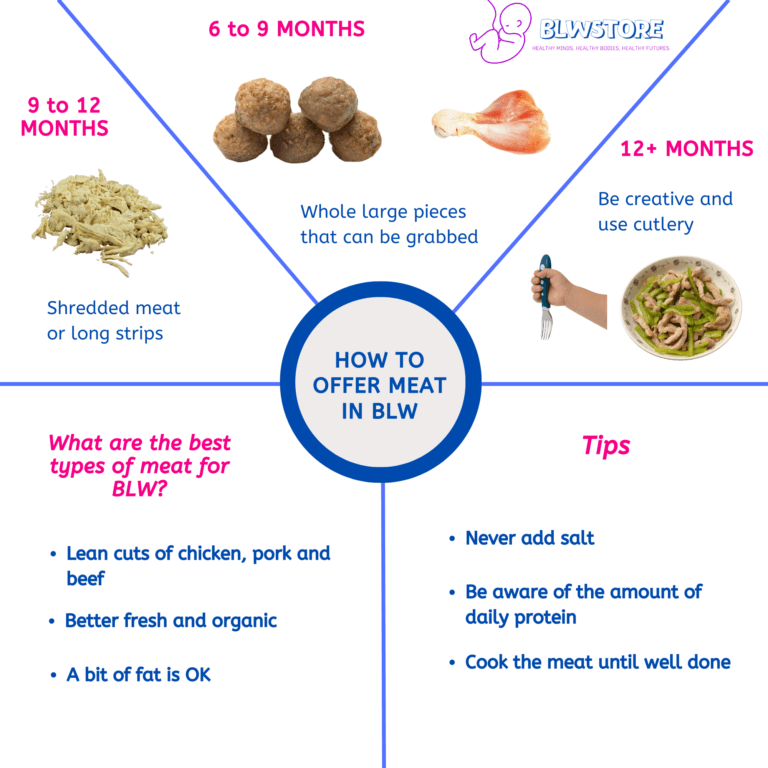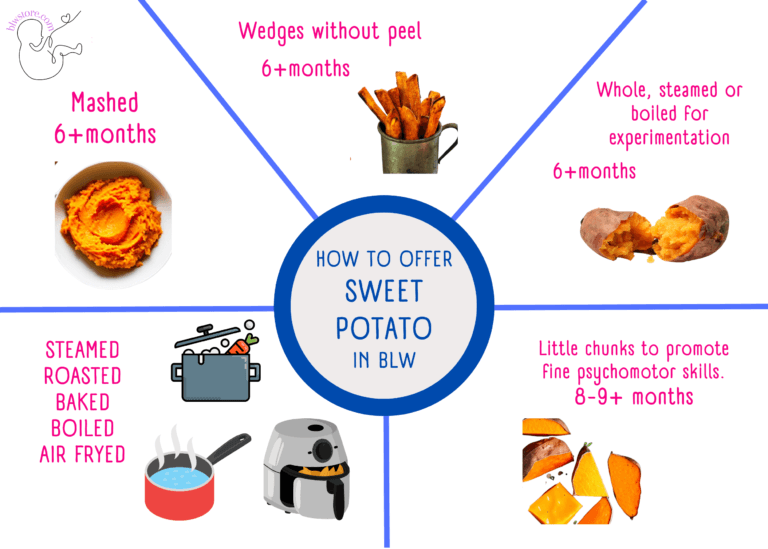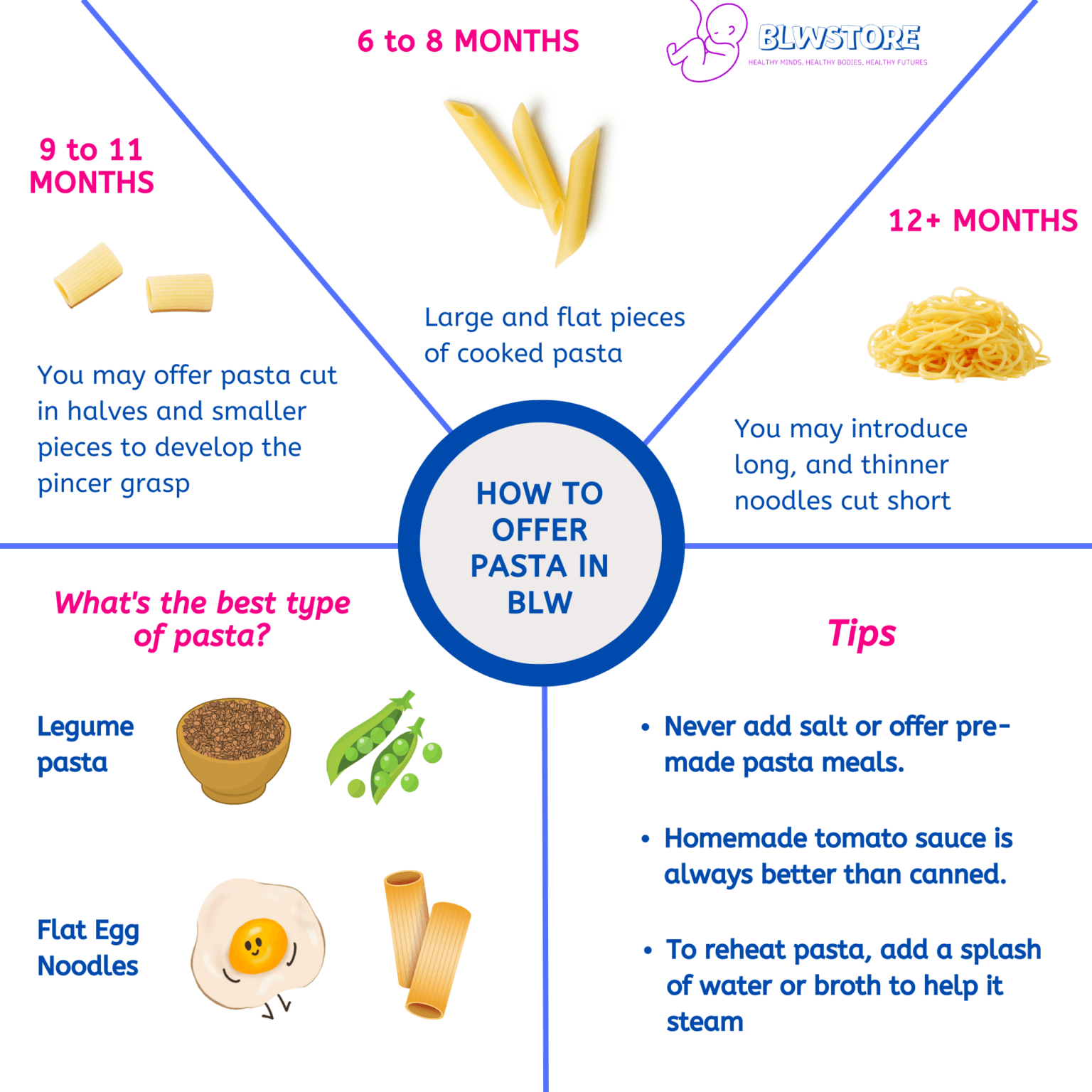
Pasta is one of the most versatile, affordable, and international foods that most people love, but is it a good option for Baby-Led Weaning?
This comprehensive guide will explore when to introduce pasta into your baby’s diet, what types of pasta are best suited for young eaters, and some delicious recipes designed with baby-led weaning in mind.
Let’s get started!
*Related read: Best Carbs for Babies
Key Takeaways
Introduce pasta to babies around 6 months of age during Baby-Led Weaning (BLW) to promote healthy eating habits and self-feeding.
Legume flour-based and whole-grain pasta are nutritious options for babies, offering higher nutritional value, protein, and fiber.
Choose age-appropriate pasta shapes, such as flat egg noodles like rigatoni or cavatappi, to reduce choking hazards.
Store cooked pasta in an airtight container in the refrigerator or freezer, and label with the date of preparation.
Cut and shape pasta according to the baby’s age and development to aid in grasping and chewing.
Homemade pasta sauces with fresh ingredients, like the provided tomato sauce recipe, are healthier alternatives to store-bought baby foods.
In our personal experience, lentil pasta is the best for babies due to its nutrient density and taste. Chickpeas or pea pasta are less appealing in terms of flavor.
BLW Pasta Basics
When introducing pasta to babies for Baby-Led Weaning, it’s essential to consider their age and readiness, the type of pasta that is safe and easy to swallow, and any potential allergies or choking hazards.
When Can Babies Eat Pasta?
BLW and pasta go hand in hand, promoting healthy eating habits and empowering babies to self-feed from an early age.
Introducing pasta to your baby can be an exciting milestone as they transition into solid foods, typically around 6 months of age.
Soft and easy-to-swallow pasta can become a perfect option for introducing solids and enhancing fine motor skills.
By six months old, a baby’s digestive system is generally prepared to handle new textures, making it suitable for incorporating nutritious pasta dishes into their diet.
With BLW focusing on offering age-appropriate finger foods that babies can easily grasp and feed themselves independently, parents can confidently incorporate safe pasta varieties in their little one’s meal plans.
This approach promotes healthier eating habits from an early stage and empowers infants to develop a sense of autonomy during mealtimes.
Is Pasta Healthy For Babies?
Yes, if you choose the good kind.
Choosing the right pasta can make all the difference in your baby’s nutrition, with legume flour-based varieties offering a higher nutritional value and promoting healthy growth and development.
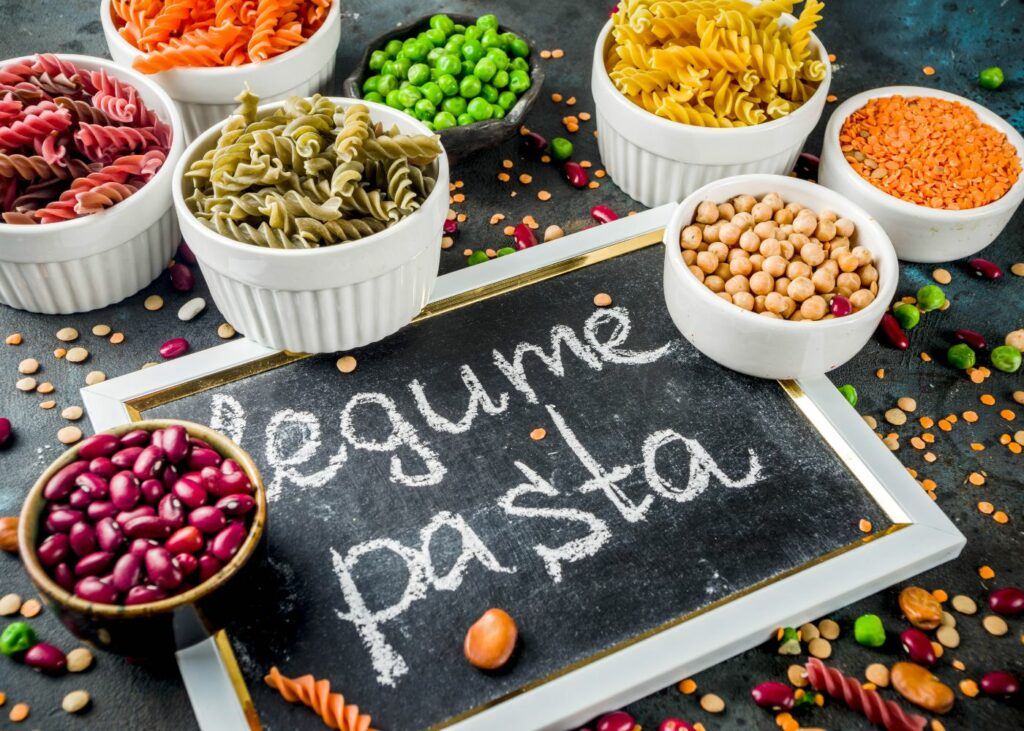
The nutritional benefits of pasta for infants largely depend on the type of pasta chosen.
Legume flour-based pasta, such as black bean or chickpea varieties, provides a higher nutritional value than traditional wheat-based options.
This means your baby will benefit from additional nutrients such as protein and fiber, essential in promoting healthy growth and development.
As with any food introduced during Baby-Led Weaning (BLW), moderation is key when serving pasta to your little one.
Whole grain pasta choices offer complex carbohydrates that serve as an energy source for babies while also providing essential nutrients like B vitamins and iron.
While store-bought baby foods can be high in sugars and additives, homemade BLW meals featuring well-cooked pasta provide a healthier alternative.
Combining nutritious ingredients with interesting textures and flavors – such as vegetables, lean proteins, or legume-based sauces – will encourage proper nutrient absorption while fostering food exploration during the early stages of solid food introduction.
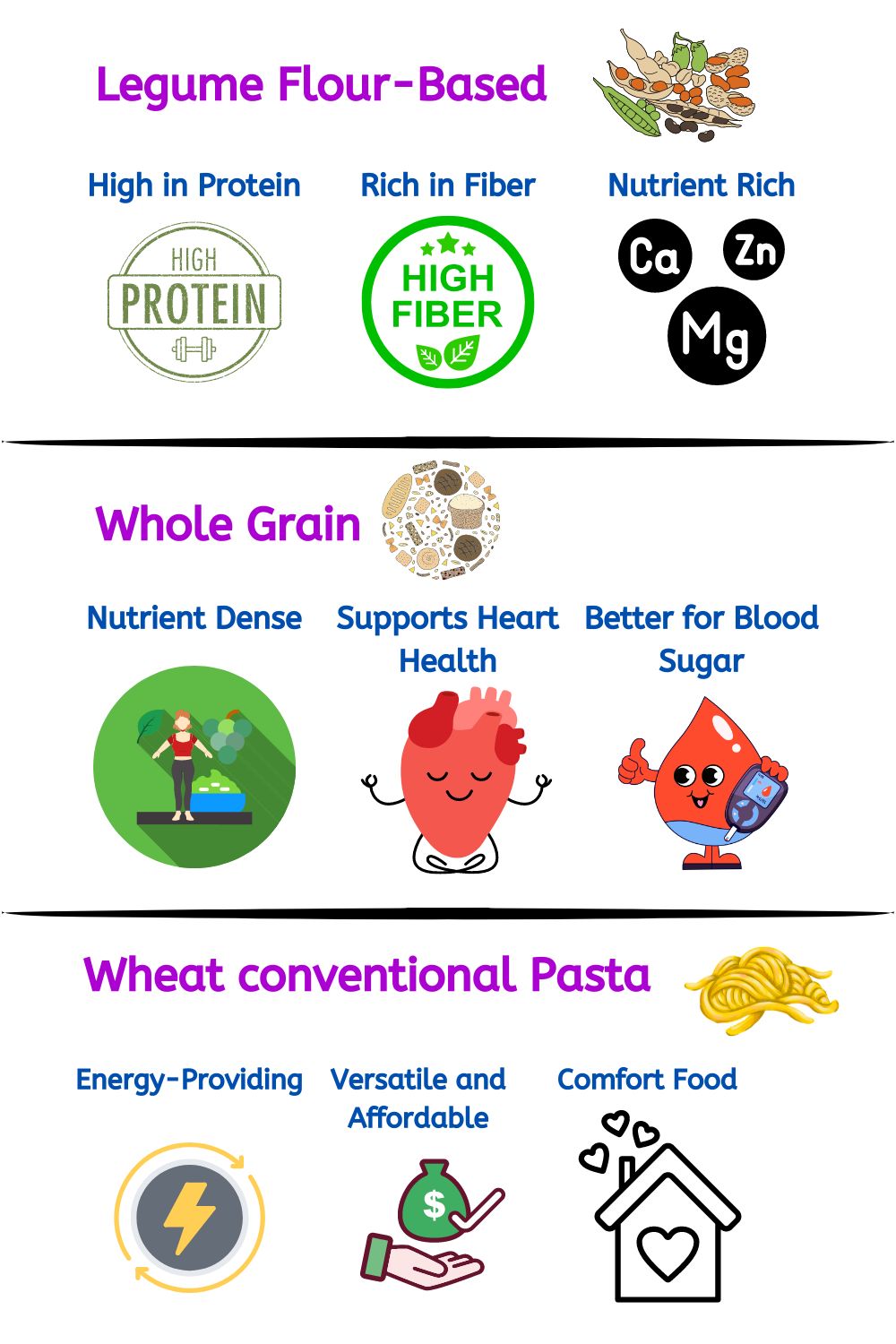
What Is The Best Type Of Pasta For Babies?
Legume flour pasta provides added nutrition and protein, making it a great option for BLW pasta.
Wide, flat egg noodles, such as rigatoni or cavatappi, can also work well for babies as they are easier to manage than thin pasta like spaghetti or ramen.
Thin pasta can be a choking hazard for babies, so choosing a noodle shape appropriate for their age and stage of development is important.
How To Store Pasta For BLW
It’s best to store pasta for BLW in single-serving portions.
This not only helps with portion control but also makes it easier to thaw out and reheat quickly when you need it.
Another important tip is to label all of your stored pasta containers with the date they were made so that you can keep track of them more easily.
| Type of Pasta | Storage Method |
|---|---|
| Raw Pasta | Store in a cool, dry place in an airtight container or resealable bag to keep out moisture and prevent the noodles from clumping together. |
| Cooked Pasta | Store in an airtight container in the refrigerator for up to 5 days or in the freezer for up to 2 months. To prevent the pasta from sticking together, toss with a small amount of olive oil or butter before storing. |
*Tip: When reheating, add a splash of water or broth to the pasta to help it steam and prevent it from drying out.
How Do You Cut and Shape Pasta for Baby-Led Weaning?
6-8 Months
You can start offering your baby large, flat noodles or sizable tubular pasta like penne or rigatoni at this age.
Their grasp is still developing, so holding pasta might be challenging.
Alternatively, try chopping spaghetti or other thin noodles and serve them in a bowl for easy hand-scooping.
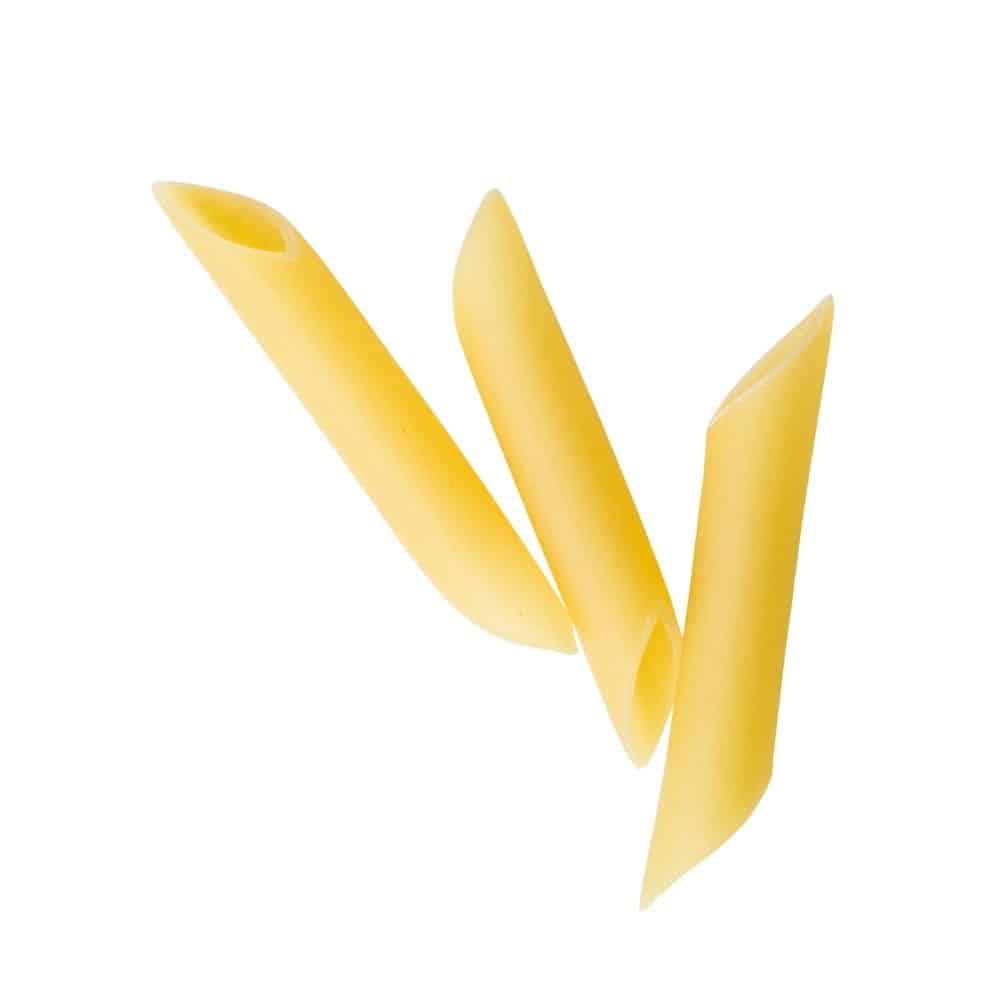
9-11 Months
As your baby’s pincer grasp develops, they can handle smaller food pieces.
Now’s the time to offer halved large tubular pasta, macaroni, or quartered ravioli.
If your little one is struggling to pick up pasta, don’t worry! You can continue serving whole pieces of large tubular pasta to help improve their biting and chewing skills.
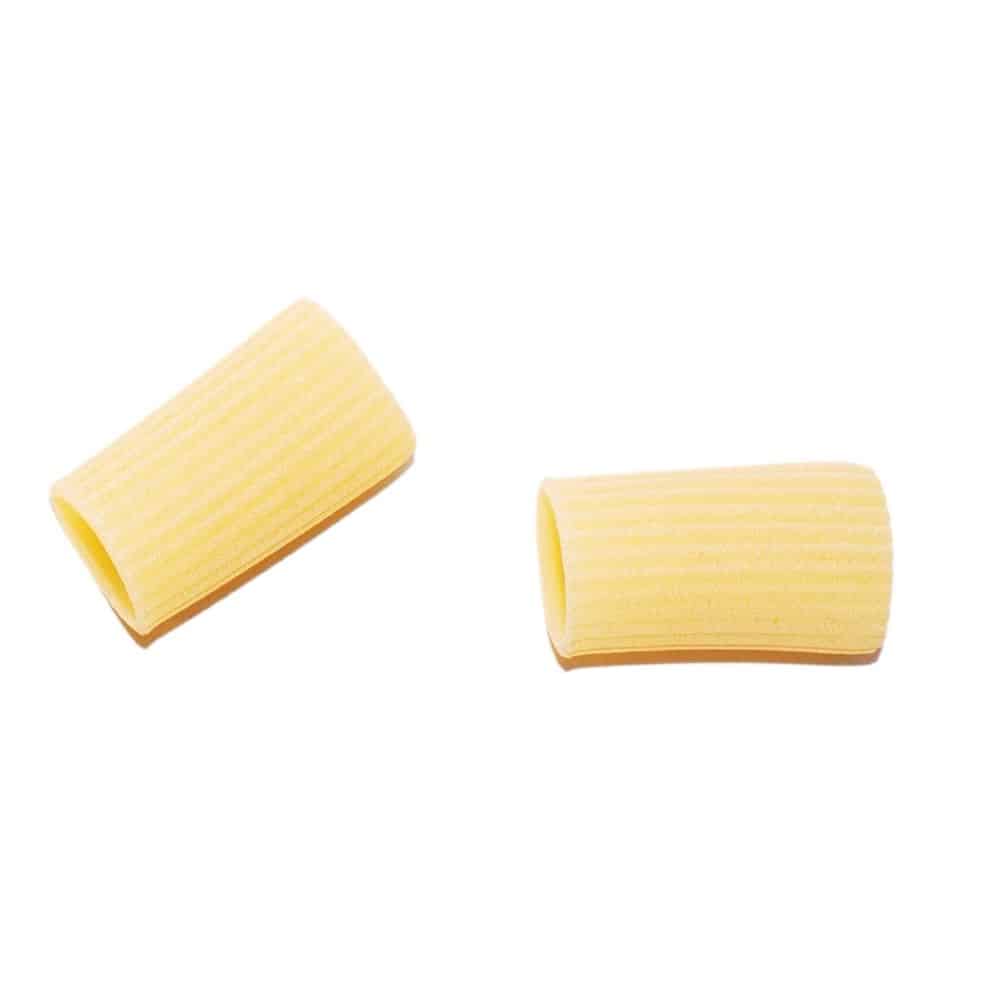
12+ Months
Your growing toddler might be ready for long, thin noodles like spaghetti, ramen, or rice noodles.
Don’t be afraid to experiment with different noodle shapes and textures.
Cut them into shorter strands as needed, and remember, scissors are your best friend here.
If your toddler still prefers to scoop noodles with their hands, that’s totally okay!
Just keep offering a pre-loaded utensil alongside their meal to encourage them to practice using it.
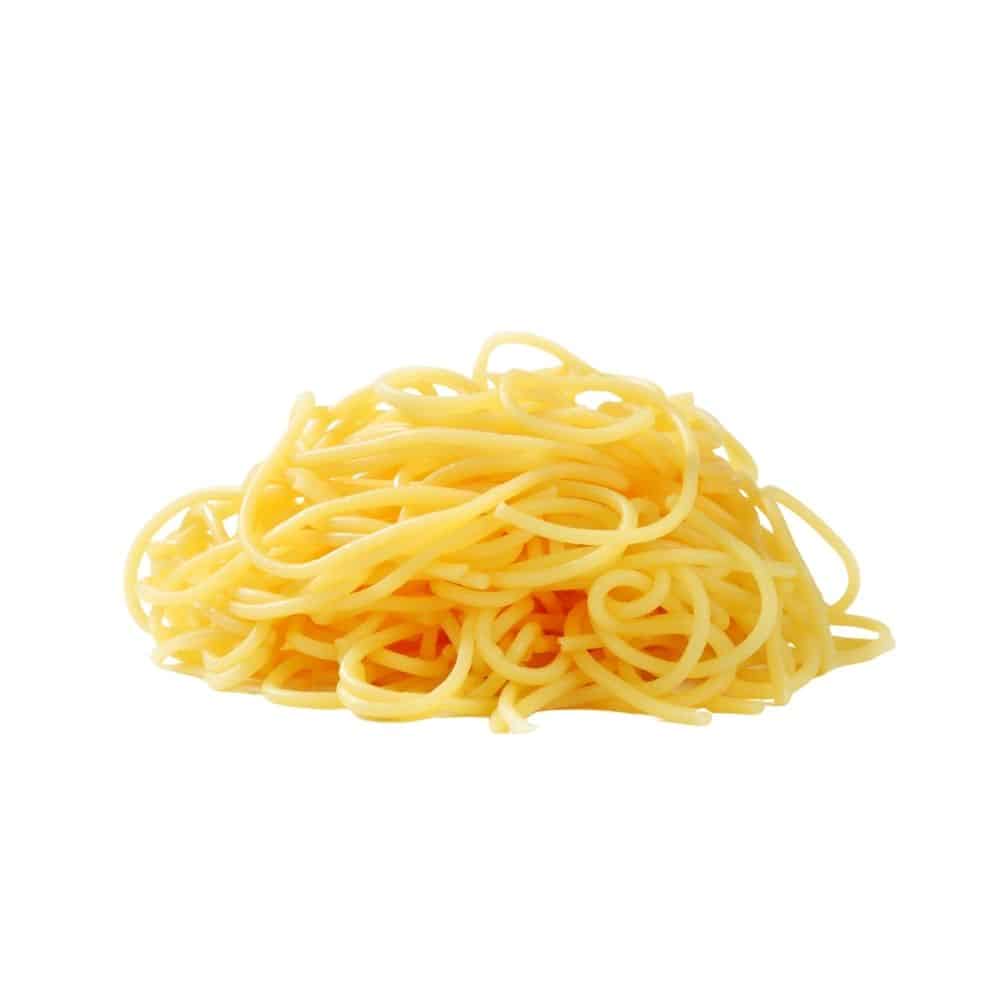
24+ Months
This is an exciting time to explore various pasta shapes and sizes with your little one.
Encourage them to try different types of pasta and let their curiosity guide the way.
This is also an excellent opportunity for your toddler to practice using various utensils. Pre-load the utensils if needed, and always be patient and supportive as they learn.
Introducing pasta to your baby is an exciting journey that involves experimenting with various shapes and sizes. Remember to be patient and supportive as your little one develops their biting, chewing, and grasping skills at their own pace.
What’s the best sauce for BLW pasta?
The best sauce for your babies and the whole family to eat is the one you make at home with good ingredients and adjusted to your children’s needs.
We like to make our own sauce with tomatoes, carrots, and red bell pepper. We always use extra virgin olive oil and spices like oregano, pepper, and basil.
Here’s the recipe we do in our house.
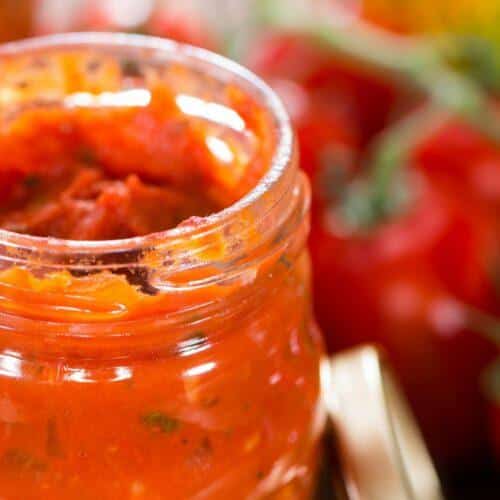
Homemade Tomato Sauce for BLW
Ingredients
- 2 tbsp extra virgin olive oil
- 1 onion (small)
- 2 garlic cloves (minced)
- 1 medium carrot (peeled and grated)
- 1 red bell pepper (finely chopped)
- 4 cups fresh or canned tomatoes, chopped (if using canned, choose low-sodium or no-salt-added)
- 1 tsp dried oregano
- 1 tsp dried basil
- 1/2 tsp black pepper
- A pinch of salt (optional for older children and adults)
Instructions
- Heat the extra virgin olive oil in a large saucepan over medium heat.
- Add the chopped onion and cook for about 5 minutes or until softened and translucent.
- If using garlic, add the minced garlic and cook for another 1-2 minutes until fragrant.
- Stir in the grated carrot and chopped red bell pepper, cooking for 5 minutes or until the vegetables are softened.
- Add the chopped tomatoes to the saucepan. You may need to add water to achieve the desired consistency using fresh tomatoes.
- Mix in the dried oregano, dried basil, and black pepper. You can add a pinch of salt for older children and adults, but it’s best to leave it out for babies.
- Bring the sauce to a gentle boil, then reduce the heat to low and let it simmer for 20-30 minutes, or until the sauce has thickened and the flavors have melded together.
- Taste the sauce and adjust the seasoning if needed. You can blend the sauce using an immersion or regular blender for a smoother texture, but be cautious if the sauce is still hot.
Notes
- This tomato sauce can be stored in the refrigerator for up to 5 days or frozen for up to 3 months.
- You can use this sauce as a base for other recipes, such as pasta dishes, soups, or stews.
- Feel free to add or substitute other vegetables, such as zucchini or eggplant, to the recipe to make it your own.
- This sauce is a great way to introduce your baby to a variety of flavors and textures.
Nutritious and easy Pasta recipes for Baby Led Weaning
These are some baby-friendly and simple recipes that you can make at home in minutes with few ingredients.
Extra-Veggie Baby Pasta
Ingredients:
2 cups pasta of choice, cooked
1 cup mixed veggies (e.g., carrots, peas, broccoli), steamed
1 cup homemade tomato sauce (see previous recipe)
Instructions:
Mix cooked pasta, steamed veggies, and homemade tomato sauce.
Serve immediately, ensuring the dish is at an appropriate temperature for your baby.
We like to use spiral-shaped pasta for a better grip if your baby eats with their hands.
Cheesy Pasta for Babies
Ingredients:
2 cups pasta of choice, cooked
1 cup fresh mozzarella, cubed or grated
Instructions:
Combine cooked pasta and fresh mozzarella.
Stir until the cheese melts and coats the pasta evenly.
Avocado Pesto Pasta
Ingredients:
2 cups pasta of choice, cooked
1 ripe avocado
1 cup fresh basil leaves
1/4 cup extra virgin olive oil
1/4 cup grated Parmesan cheese (optional)
Instructions:
Combine avocado, basil leaves, olive oil, and optional Parmesan in a blender or food processor.
Blend until smooth.
Mix the avocado pesto with cooked pasta.
Ensure the dish is at an appropriate temperature before serving to your baby.
Sweet Potato Mac and Cheese
Ingredients:
2 cups pasta of choice, cooked
1 cup cooked sweet potato, mashed
1 cup fresh mozzarella, cubed or grated
Instructions:
Combine cooked pasta, mashed sweet potato, and fresh mozzarella.
Stir until the cheese melts and the mixture is well combined.
7 Tips For Enjoying BLW Pasta With Your Baby
| Tips For Enjoying BLW Pasta With Your Baby |
|---|
| 1. Choose pasta shapes that are easy for your baby to pick up and hold, such as fusilli or penne. |
| 2. Offer a variety of baby friendly sauces and toppings to expose your baby to different flavors and textures. |
| 3. Encourage self-feeding by placing small portions of pasta directly on your baby’s tray or high chair surface. |
| 4. Be patient and allow your baby to explore and enjoy their pasta at their own pace. |
| 5. Make mealtime enjoyable by offering praise and positive reinforcement when your baby tries new foods or demonstrates good eating habits. |
| 6. Avoid distractions (TV/Radio) during mealtime as this can take away from the focus on food exploration. |
| 7. Monitor your baby closely during mealtimes to ensure they are not choking or experiencing any adverse reactions. |
| Troubleshooting Pasta Challenges |
|
Cut the pasta into appropriate pieces that are easy for your baby to manage to prevent choking. |
| Keep your baby seated in an upright position while eating and watch them closely at all times. |
| Experiment with different types of pasta and sauces if your baby is not enjoying it right away. |
| Consider offering finger foods alongside the pasta to encourage exploration and create variety. |
| Use a bib and place a mat underneath the high chair to make cleaning up easier. |
FAQs
How do you boil pasta for babies?
The same as for adults, but always cook until soft or very soft.
Do you add salt to pasta water for baby?
No, it’s recommended not to add salt to the pasta water when cooking for babies, as their kidneys are not yet fully developed to process high amounts of sodium up until the 24-month mark.
Can a baby eat pasta with no teeth?
Yes, babies can eat pasta even if they don’t have teeth, as long as it’s cooked until very soft and easy to gum or chew.
Which pasta is best for a baby?
Legume-based pasta (lentil, chickpea, etc.) is a great source of protein and fiber.
Whole grain pasta is rich in nutrients and fiber, promoting healthy digestion.
Flat egg noodles like rigatoni or cavatappi are easy for babies to pick up and chew.
Can pasta cause gas in babies?
Pasta itself is unlikely to cause gas in babies. However, certain ingredients or sauces might cause gas or bloating.
Monitor your baby’s reaction to new ingredients and adjust their diet accordingly.
Is spaghetti safe for baby-led weaning?
Yes, spaghetti is safe for baby-led weaning, but only for babies 12+ months old.
Make sure to cook the spaghetti until it’s soft and cut it into shorter lengths to make it easier for the baby to handle and chew.
We’re Maria and Alberto, a married couple and educators who are nutrition enthusiasts. Even before we had kids, we were already crazy about nutrition.
We’d read scientific articles, watch videos from nutritionists, and spend hours listening to nutrition podcasts.
Today, we continue doing this, but in a different way, as we’ve learned to sift through the noise and trends. Nutrition, like any other field of knowledge, the more you read and learn, the more you develop a comprehensive understanding of reality, and that’s what has happened to us.
Before having our first child, we focused on learning everything we could about child nutrition, using the same techniques we had already employed, backed by our extensive knowledge in nutrition.
Our mission is to help other parents with their children’s nutrition, to help them become the best versions of themselves.
If we are what we eat and drink, which is absolutely true, let’s do it right!


